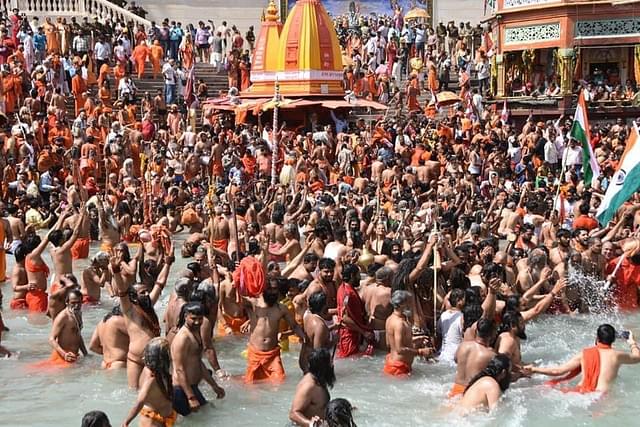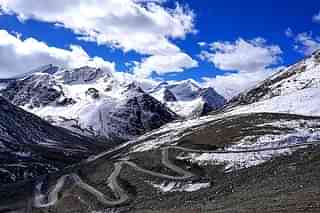Commentary
Series Of Crucial First Steps: Mahants Who Belonged To SC Communities In Pre-Sanyas Life Appointed Mahamandaleshwars
Aravindan Neelakandan
May 03, 2024, 09:39 PM | Updated May 04, 2024, 12:26 PM IST
Save & read from anywhere!
Bookmark stories for easy access on any device or the Swarajya app.

For Hindus this is an important step forward. But only a step.
In the past, Hindus have taken many such steps, but they have often failed to sustain the momentum.
A good example is the 1969 Udupi Conference against untouchability organised by the second all India leader of the RSS, ‘Guruji’ Golwalkar.
In a subsequent letter written to Surya Narayana Rao, one of the energetic leaders then working in southern India, Golwalkar wrote that this was a first step and they had to make sure that untouchability was removed from the minds of each and every so-called 'caste' Hindu. To that end, Golwalkar emphasized that passing the resolution was the easy part, compared to the difficult path ahead.
Media reports claim that the mahants are the first such leaders from the Scheduled Communities. However, a careful study of history shows earlier instances as well where spiritual leaders emerged from economically exploited and socially excluded groups and galvanised their communities toward social emancipation through spiritual traditions.
Take this history of the Satnamis.
The Satnamis first appear in history as rebels against Aurangzeb. Ordinary peasants and carpenters and goldsmiths and sweepers took up their tools and fought an impossible battle against the well-organised Mughal army, equipped with arms and ammunition. They were of course crushed and hunted down by the Mughal forces but not before they inflicted heavy damage. Their courage against all odds creating a panic among the Mughal soldiers, so much so that Aurangzeb himself had to intervene, according to some traditions.


Soon the Satnamis resurfaced. They gathered around a Guru. The tradition eschewed meat and wore the sacred yajnopavita.
They might not worship any forms but they have great reverence for Ram and Krishna and Hanuman.
During the early decades of colonisation, there was stiff opposition from the so-called upper castes to the Satnamis wearing the sacred thread. But despite violence unleashed on them they insisted. As late as 1890, they had their Guru perform the Dig Vijaya, a tradition akin to that of any other Acharya in the Hindu tradition, complete with a retinue of elephants and camels.
British documents reveal that famines severely impacted vulnerable sections of society. As a result, the surplus that the Satnami communities could use to build religious institutions slowly dried up. The deteriorating land-labor equations in Indic society further worsened, affecting the majority of the community, which led to missionaries intervening.
The most sacred day of guru pooja for the Satnamais was Vijaya Dashmi. On that day a Christian missionary, Oscar Lohr, of the German Evangelical Mission Society barged into their guru pooja and declared that they did not have the right call themselves Satnamis or worshipper of the True Name unless of course they accepted Jesus who was the true name.
Lohr spoke for four hours and when he was exhausted, he himself recorded, the Satnami Guru offered him refreshments.
And he had come to civilize them!
Satnamis did listen to the Jesus stories the missionaries told them. Three were even ready to become Christians. A huge convention was arranged and when the time came the missionary asked them to remove their yajnopavita before baptism. They simply refused. In fact, other Satnamis who were under the missionary spell also refused.
This flow of the spiritual authority as manifested in Satnami Guru Parampara is Sanatana Dharma. The stagnation is because of socio-economic factors. This causal attribution should be clear to each one of us Hindus.
It is here one needs to meditate upon the vision of Swami Vivekananda of the future India. He said:
You are but mummies ten thousand years old! It is among those whom your ancestors despised as "walking carrion" that the little of vitality there is still in India is to be found; and it is you who are the real "walking corpses".... Ay, on your bony fingers are some priceless rings of jewel, treasured up by your ancestors, and within the embrace of your stinking corpses are preserved a good many ancient treasure-chests.... You merge yourselves in the void and disappear, and let New India arise in your place.
The unusually harsh words should be understood in context. Commentators after commentators of the Brahma Sutra have called the Shudras as ‘mobile crematoria’ etc. Sanatana Dharma consistently nullified such views by producing spiritual leaders and social reformers from the most marginalised sections of society. In reality, against the flow of Sanatana Dharma, the upper classes of India, under colonialism, made a scriptural freezing of the flow.
Vivekananda reversed the insulting imagery of the commentators and called those who held the Vedanta frozen and unto themselves as mummies holding onto the most precious treasures. Then Swami Vivekananda envisioned a new India arising from the huts of peasants and fishermen and cobbler.
Let New India arise - out of the peasants' cottage, grasping the plough; out of the huts of the fisherman, the cobbler, and the sweeper. Let her spring from the grocer's shop, from beside the oven of the fritter- seller. Let her emanate from the factory, from marts, and from markets. Let her emerge from groves and forests, from hills and mountains.
Here, he envisioned not only great scientists, statesmen, engineers and doctors arising from the downtrodden masses, but also authorities of Vedantic knowledge - the spiritual leaders of Sanatana Bharat!
The future versions of Lahuleesa, Shankara and Ramanuja, Buddha, Sri Kanda and Madhva would be coming from those huts and they would protect the Dharma and carry it forward – not the mummies of India’s stagnant past which support birth-based varna and untouchability.
Today the mantle of true Sanatana Dharma has come into the hands of these four Jagat Gurus. This as ‘Guruji’ of the RSS, M.S. Golwalkar said, is the first step. The next important thing is to strengthen the institutions of these Jagad Gurus, knowledge-wise, financially and institutionally, as authorities of Dharma.
The seeds have been planted. It is now the duty of the entire Hindu society to nurture them.
Hindus should also guard against the usual temptation of making caste based separate sampradayas and then claim that all castes have equal authority while in reality some sampradayas get marginalised and others gather clout.
All Hindu sampradayas and all institutions should be democratised, in the sense that they should be open to all jaatis.
Democratising all Hindu Sampradaya Institutions with all jaatis is an important step that will lead inevitably and irreversibly to Hinduising all walks of Indian society, including politics.
This writer has been long crying that Dharmacharyas should start addressing social evils like untouchability and caste atrocities as a severe crisis of Dharma in society. The writer humbly bows down at the sacred feet of each of the Holiness Jagad Guru Mahamandaleshwars and wishes their Dharmic mission only success and the greatest success.
Save & read from anywhere!
Bookmark stories for easy access on any device or the Swarajya app.
Support Swarajya's 50 Ground Reports Project & Sponsor A Story
Every general election Swarajya does a 50 ground reports project.
Aimed only at serious readers and those who appreciate the nuances of political undercurrents, the project provides a sense of India's electoral landscape. As you know, these reports are produced after considerable investment of travel, time and effort on the ground.
This time too we've kicked off the project in style and have covered over 30 constituencies already. If you're someone who appreciates such work and have enjoyed our coverage please consider sponsoring a ground report for just Rs 2999 to Rs 19,999 - it goes a long way in helping us produce more quality reportage.
You can also back this project by becoming a subscriber for as little as Rs 999 - so do click on this links and choose a plan that suits you and back us.
Click below to contribute.





